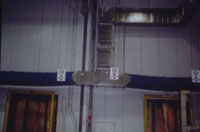
These commercial facilities traditionally rely on heated high-speed freezer entrance doors to address ice and snow accumulation when humid outdoor air mixes with the freezer's -10 degrees Farenheit conditions.
In dry climates, a freezer entrance door adequately maintains desired conditions and conserves energy. In Florida, however, where there's an American Society of Heating, Refrigerating, and Air Conditioning Engineers (ASHRAE) 0.4% design dew point of 79 degrees Farenheit and a humidity ratio of 151 grains/lb., heated freezer entrance doors can't eliminate ice build-ups.
Mechanical engineer, Gary Evans, manager of HVAC sales at manufacturer's representative/distributor, System Components Corp., Ocala, FL, teamed up with HVAC contractor, Bentzel Mechanical, St. Petersburg, FL, to solve incessant ice build-ups at a Bradenton, FL-based 320,000-square-foot refrigerated warehouse. The duo used a combination of desiccant equipment and fabric duct air distribution as an energy-saving, maintenance-cutting supplement to heated freezer entrance doors.
Bentzel Mechanical installed a desiccant dehumidifier Model F-30 FreezAires (400lbs./hr. of moisture removing capacity) by Munters-North American Dehumidification Division, Amesbury, Mass. Meanwhile, Evans designed the air distribution system featuring custom-engineered fabric duct manufactured by FabricAir Inc., Louisville, KY.
Using a desiccant system and industrial-grade fabric duct to distribute dehumidified air is a unique solution to this age-old problem, however, the projected two-year payback on the $130,000 project and the concept's efficiency is now getting attention from other Florida refrigerated warehouse facility operators. The payback comes from an 80 percent reduction in costly semi-daily defrost cycles for each of the 140,000-square-foot freezer/cooler's 21 evaporator coils and dozens of rooftop condensing coils. Now the Bradenton plant has reduced the ammonia refrigeration system's defrost cycles to only once per week. The energy saved from reduced defrost cycles was initially estimated by Evans and verified by a Florida Power and Light energy audit.
The payback doesn't include estimates of an additional $50,000 annual savings for ice removal on the 40 X 360-foot trucking dock that was previously performed with in-house maintenance people, according to Evans. Ice had regularly accumulated on the floor and ceilings as far as 20 feet from each of the four 14 X 8foot automatic entry freezer door thresholds. "With the new desiccant and fabric ductwork system, we reduced relative humidity from worse case scenarios of 90% to a constant everyday 40% R.H." said Evans.
The five-year-old facility saved an additional $90,000 by not installing a supplementary heated vestibule system estimated at $240,000. "Heated vestibules don't completely eliminate the ice like a desiccant system can," added Evans. "Granted, a desiccant system uses natural gas that raises our utility costs, but that expenditure is saved with a reduced electrical load needed from limited defrost cycles in a less humid atmosphere. Heated vestibules would not offer this advantage."
Bentzel Mechanical installed the 10,000-cfm desiccant system and subcontracted the fabrication of the sheet metal supply and return to Express Metals, St. Petersburg, FL. The supply duct connects the rooftop desiccant unit to the 140-foot-long run of 42-inch-diameter fabric duct that runs just above the four freezer doors. The project also includes 180 feet of 40 X 24-inch metal return duct with 12 grills that are spread evenly along the 23 truck dock openings.
Typically, fabric duct distributes air through fabric permeability and/or linear diffusers.

The Bradenton plant manager also likes the aesthetic appearance and the easy maintenance that accompanies fabric duct. FabricAir used custom coloring to match the firm's corporate blue color. Fabric duct simply springs back to its original shape when bumped by objects such as forklifts or pallets, whereas metal duct is permanently damaged. In the inevitable event of a forklift irreversibly damaging the duct, the plant's maintenance department has replacement sections in stock that his maintenance crew can install in less than one hour. A damaged metal duct however, would require a system shutdown and repairs by a sheet metal contractor.
The maintenance department also plans to clean the duct routinely, because disassembling, cleaning, and replacing can be accomplished with in-house maintenance staff in an estimated four-hour period.
Using a desiccant and fabric ductwork system to eliminate ice build-up is just another example of how high technology is improving the food warehousing and distribution industry.
Publication date: 08/13/2001

Report Abusive Comment